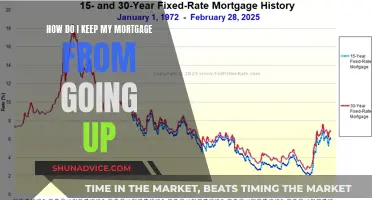
Refinancing a mortgage involves taking out a new loan to pay off and replace your original mortgage loan. This is typically done to take advantage of lower interest rates or improve the loan terms, such as the monthly payment or length of the loan. When refinancing, you'll need to file an application, go through the underwriting process and close. You'll also need to provide financial documentation, such as proof of income, assets, debt, and credit score. It's important to consider the costs and fees associated with refinancing, as well as your financial situation and goals, to determine if it's the right decision for you.
| Characteristics | Values |
|---|---|
| Definition | Refinancing a mortgage means taking out a new loan to pay off and replace the original mortgage loan. |
| Purpose | To obtain more favorable borrowing terms, such as a lower interest rate, lower monthly payments, or a shorter loan term. |
| Application Process | Similar to the process for a new mortgage: the lender will run a credit check, request financial documentation, and review income, assets, debt, and credit score. |
| Costs | Closing costs and fees can be significant, typically ranging from 3% to 6% of the total loan value. No-closing-cost options are available but may result in a higher interest rate. |
| Timeline | The process typically takes 30 to 45 days, with an average time to close of 48 days as of January 2025. |
| Considerations | Compare rates and terms from multiple lenders, calculate the break-even point, and consider your financial situation and goals. |
What You'll Learn

How to refinance your mortgage
Refinancing your mortgage can be a smart financial move if you're looking to reduce your monthly payments, shorten the term of your loan, or get access to cash for other necessary expenses. It involves taking out a new loan to pay off your original mortgage loan, ideally with a lower balance and a more favourable interest rate.
Here's a step-by-step guide on how to refinance your mortgage:
Step 1: Evaluate your financial situation
Before starting the refinancing process, it's essential to assess your financial situation and goals. Ask yourself: How long do I plan to stay in my home? Will refinancing result in overall savings? Am I looking to lower my monthly payments, shorten the loan term, or get rid of mortgage insurance? Answering these questions will help you decide if refinancing is the right choice for you.
Step 2: Shop around for lenders and get quotes
Compare multiple lenders' interest rates, availability, and client satisfaction scores. Getting quotes from at least three lenders will help you maximise your savings. Consider using a mortgage refinance calculator to determine your break-even point, taking into account the upfront costs and fees associated with refinancing.
Step 3: Prepare your documentation
Gather the necessary financial documentation, including recent pay stubs, federal tax returns, bank statements, and any other relevant documents requested by your lender. Your lender will also evaluate your credit score, income, assets, debt, and net worth, so be prepared to disclose all your financial information.
Step 4: Submit your application
Once you've chosen a lender, submit your refinancing application. The lender will review your financial information and run a credit check. This process is similar to when you applied for your original mortgage but is generally less strenuous.
Step 5: Underwriting and closing
After submitting your application, your loan will go through the mortgage underwriting process. This typically takes around 30 to 45 days, and then the closing process will follow. During closing, you'll sign the necessary paperwork to finalise the refinance, and your new lender will pay off your original loan.
Remember, refinancing your mortgage can provide significant benefits, but it's important to carefully consider your unique financial situation and seek out the best available terms to ensure you make the right decision.
Who Holds Your Mortgage? A Guide to Finding Out
You may want to see also

The advantages of refinancing
Refinancing your mortgage can have several advantages, depending on your financial situation and the type of loan you are eligible for. Here are some key advantages:
Lower Interest Rates and Monthly Payments
A common reason for refinancing is to secure a lower interest rate, which can help reduce your monthly mortgage payments and save you money over time. This is especially beneficial if interest rates have dropped since you first took out your mortgage or if your credit score has improved, as lenders may offer you more favourable rates.
Shorter Loan Term
Refinancing can also help you pay off your mortgage faster by reducing the term of your loan. For example, if you've been paying off a 30-year loan for several years, refinancing to a 20-year loan with a lower interest rate may not significantly increase your monthly payments, allowing you to own your home sooner.
Switch to a Fixed-Rate Mortgage
If you have an adjustable-rate mortgage (ARM), refinancing can allow you to switch to a fixed-rate mortgage. This provides more stability and predictability in your monthly payments, as the interest rate on an ARM can fluctuate over time based on market conditions.
Access Home Equity
Refinancing allows you to access the equity you've built up in your home through a cash-out refinance. This can be useful for financing home improvements, paying off high-interest debt, or covering large expenses such as medical bills or college tuition.
Eliminate Private Mortgage Insurance (PMI)
Refinancing may also provide an opportunity to eliminate PMI, which is required on certain types of loans, especially if you now have more than 20% equity in your home.
It's important to note that refinancing a mortgage also comes with potential drawbacks, such as closing costs and negative impacts on your credit score, so it's essential to carefully consider your unique financial situation and seek professional advice before making any decisions.
Who Services My Mortgage? Find Out Now
You may want to see also

When is a good time to refinance?
When interest rates fall, refinancing your mortgage can save you money on your monthly payments and over the long term. A traditional rule of thumb is that if mortgage rates are lower than your current rate by 1% or more, it might be a good idea to refinance. However, this is not always the case, and refinancing can still make sense if you can get a 0.5% improvement in your interest rate.
If you have a good credit score, you are more likely to get a competitive rate. It is a good idea to build up your credit score before refinancing, as this can help you get a better rate. You should also consider the fees associated with taking out a new loan, such as closing costs, which can amount to thousands of dollars. It can take a few years to break even on these costs, so if you are planning to move soon, it might not make financial sense to refinance.
You can use a mortgage refinance calculator to figure out your break-even point and determine whether refinancing makes sense for you. If you can afford it, you may want to refinance from a 30-year to a 15-year loan. This will significantly increase your monthly payments but can also lower the amount of interest paid over the life of the loan.
It is important to remember that mortgage refinance rates change throughout the day, every day, so it can be challenging to time the market. However, if you have an opportunity to save, experts say you should take advantage of it rather than holding out for lower rates.
Understanding Mortgage Foreclosure: Your Guide to the Process
You may want to see also

How to calculate your break-even point
When considering refinancing your mortgage, it is important to calculate your break-even point. This is the point at which your savings exceed the costs of the new loan, or when your accumulated monthly savings are greater than the refinance closing costs. It can take a few years to reach this point, so if you are planning to move soon, refinancing may not be the best option.
To calculate your break-even point, you will need to determine the total loan costs, which include fees and refinance closing costs. When you apply to refinance, lenders will provide a Loan Estimate form detailing these costs. Lender fees may include origination or application fees, as well as any discount points you choose to buy. There will also be title costs, including a title search and insurance, and third-party costs such as an appraisal, attorney's fees, or the cost of a credit report ordered by the lender. Escrow services for taxes and insurance may also be included. Closing costs typically range from 2% to 6% of your outstanding principal balance.
Once you have calculated your total loan costs, you can determine your monthly savings by subtracting your new monthly mortgage payment from your old one. Finally, divide your total loan costs by your monthly savings to find the number of months it will take to break even. For example, if your refinancing fees total $5,000 and you will save $200 per month, it will take 25 months to recoup the cost of refinancing.
It is worth noting that the break-even point may vary depending on the interest rate, loan term, and closing costs associated with each mortgage. If you are considering refinancing to save money on your monthly payments, it is important to take into account how long you plan to stay in the home. If you intend to move or refinance again before reaching the break-even point, refinancing may not be the best financial decision.
Accessing Your Mortgage Statement: A Quick Guide
You may want to see also

Documents you'll need
When you refinance your mortgage, you'll need to provide documentation to support your application. The documents you'll need are similar to those required when you applied for your original mortgage. Your lender will review your income, assets, debt, and credit score to determine whether you meet the requirements to refinance and can pay back the loan.
- Recent pay stubs
- Federal tax returns (it's a good idea to have returns from the last couple of years handy)
- Bank/brokerage statements
- Proof of legal U.S. residency
- Any other documentation your mortgage lender requests
Your lender may also need your spouse's documents if you're married and live in a community property state, regardless of whether your spouse is on the loan. If you're self-employed, you might be asked for more income documentation.
Finding Mortgage Records: A Comprehensive Guide
You may want to see also
Frequently asked questions
Refinancing a mortgage involves taking out a new loan to pay off and replace your original mortgage loan. This is usually done to take advantage of lower interest rates or improve the loan terms, such as the monthly payment or length of the loan.
It depends on your circumstances. Generally, it's a good idea to refinance when interest rates are lower than when you bought your house, as it could save you money. You may also want to refinance if your credit score has improved since you bought your house.
Refinancing can be a smart financial move if it reduces your monthly mortgage payment, shortens the term of your loan, or provides cash for necessary expenses.
Refinancing can involve significant closing costs and fees, so you may not realise savings for several years. It can also negatively impact your credit score.
The process is similar to getting a new mortgage. You'll need to file an application, go through the underwriting process, and close. You'll also need to provide the same information and documentation as when you bought your home, such as proof of income, assets, debt, and credit score.







